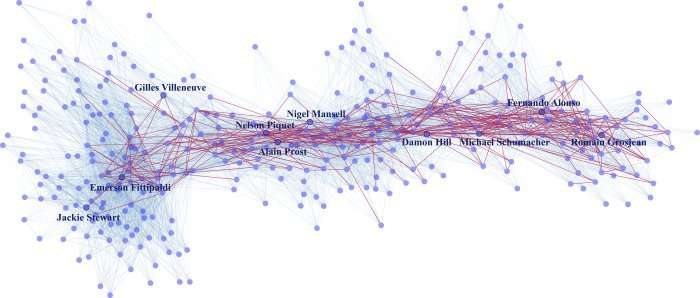March 27, 2018 report
Study suggests race car drivers who are similar in age and stature more likely to crash in good weather

A team of researchers with Korea Advanced Institute of Science and Technology, the U.S. Treasury and the European School of Management and Technology has found via data analysis that Formula 1 race car drivers are more likely to crash if they are racing against an opponent who is similar in age and driving prowess when driving under safe conditions. In their paper published in the Proceedings of the National Academy of Sciences, the group describes their study of racing data and what they learned about race car driver behavior under escalating competitive conditions.
Race car driving is an intense sport—drivers push their cars in excess of 200 mph while competing against other skilled drivers, which, despite recent technology advances, still represents quite a risk—drivers are still killed in wrecks sometimes. But the researchers wanted to determine the factors that lead to actual crashes. To find out, they obtained Formula 1 racing data for the years 1970 to 2014, which covered 732 races and 355 drivers, and analyzed it looking for patterns. One pattern is the heightened risk of a crash during good weather when drivers are similar in age and stature (when both are considered to have similar driving skills as noted by their ranking). A notable example would be the rivalry between Lewis Hamilton and Nico Rosberg—despite being teammates, the two have managed to rack up an impressive number of collisions, often with one another.
The work was based on what those in the social sciences describe as the structural equiveillance theory—in which those with similar characteristics engage in heightened competitive conflict. An extreme example, they note, would be Mike Tyson biting off Evander Holyfield's ear in the middle of a highly promoted bout. When such behavior is present in racing, the end result can often be a collision as drivers make increasingly risky moves in attempting to best an opponent. But interestingly, they found, only when the weather is good, offering safe driving conditions. Presumably, all of the drivers on a course in poor weather are much more focused on avoiding a weather-related crash.

More information: Henning Piezunka et al. Escalation of competition into conflict in competitive networks of Formula One drivers, Proceedings of the National Academy of Sciences (2018). DOI: 10.1073/pnas.1717303115
Abstract
This article investigates the factors that escalate competition into dangerous conflict. Recent sociological theorizing claims that such escalations are particularly likely in dyads of structurally equivalent people (i.e., actors who have the same relations with the same third parties). Using panel data on Formula One races from 1970 through 2014, we model the probability that two drivers collide on the racetrack (an observable trace of conflict) as a function of their structural equivalence in a dynamic network of competitive relationships. Our main hypothesis, that the likelihood of conflict rises with structural equivalence, receives empirical support. Our findings also show that the positive association between structural equivalence and conflict is neither merely a matter of contention for official position nor an artifact of inherently hostile parties spatially exposed to each other. Our analyses further reveal that this positive association is concentrated in a number of theoretically predictable conditions: among age-similar dyads, among stronger performers, in stable competitive networks, and in safe, rather than dangerous, weather conditions. Implications for future research on conflict, networks, and tournaments are discussed.
Journal information: Proceedings of the National Academy of Sciences
© 2018 Phys.org




















